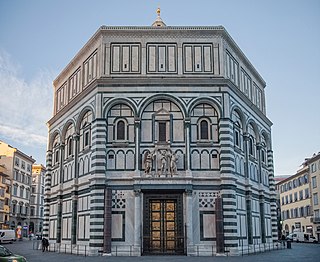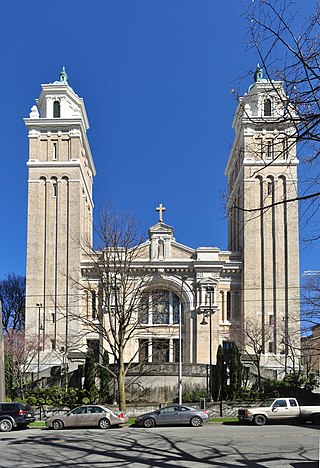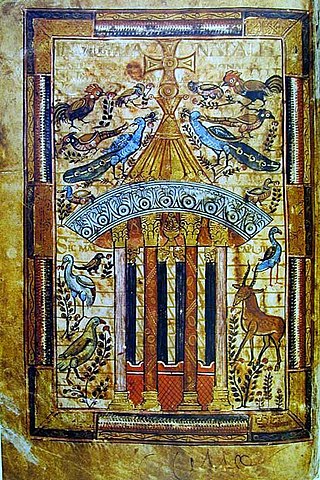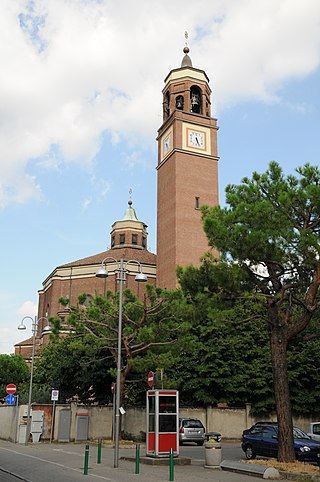
The Baptistery of San Giovanni is a Paleochristian baptistery attached to the Santa Restituta church in Naples, Italy. It is the oldest surviving baptistery from medieval Europe. [1]

The Baptistery of San Giovanni is a Paleochristian baptistery attached to the Santa Restituta church in Naples, Italy. It is the oldest surviving baptistery from medieval Europe. [1]
The baptistery was likely built in the fourth century. There are conflicting accounts of who commissioned the construction of the baptistery and when. Severus, the twelfth bishop of Naples, is often credited with its construction in the late fourth century. [2] The construction of the baptistery by Severus is chronicled in John the Deacon’s Gesta episcoporum Neapolitanorum. [3] However, the thirteenth–fourteenth century work Chronicle of Saint Mary of the Principle, credits Constantine the Great with the building of the baptistery at the same time as the S. Restituta during the early fourth century. [4] The architecture and mosaic style lead researchers to believe that the baptistery was more likely to have been constructed in the later fourth century. The baptistery was remodeled under the nineteenth Bishop of Naples, Soter (465–486). [2]

The baptistery is approximately 7 × 7 meters. [2] The interior is octagonal with a domed roof. The piscina, 2 meters across and 45 cm deep, is made of earthenware. [2] The piscina was not deep enough for the baptized to be fully submerged. Instead of full immersion, the baptized stood in the piscina and the water was poured over their head three times. [5] This is evidenced by baptism iconography located in the Roman Catacombs. [5]
The baptistery was once a freestanding building. The original entrance consisted of two openings in the western wall. [6] This establishes the original orientation of the building as east to west, not the north to south that we see today. [6] This is also supported by the orientation of the mosaics. Today, one enters the baptistery through a chapel behind the main apse in S. Restituta. Additionally, the baptistery can be entered through a porch on the northern side of the building. This porch connects the baptistery to the archiepiscopal palace. [2]

In the center of the dome roof is the Chi Rho symbol. The golden Chi Rho mosaic sits on a deep blue background and is surrounded by gold, blue, and white stars. The Chi Rho is flanked by the letters alpha and omega, in reference to Revelation 1:11. Above the Chi Rho is the hands of the Eternal Father (Dextera dei) clutching a jeweled laurel wreath wrapped in a golden ribbon. [4]

In this scene, Jesus stands atop a blue orb and hands Saint Peter the scroll of law. Written on the scroll is Dominus Legem Dat, Latin for "the Lord gives the law". While the left side is badly damaged, it can be assumed that the figure to Jesus's left is Paul the Apostle based on early Christian iconography.
There are several mosaics of biblical scenes lining the walls beneath the dome. To the right of the Traditio Legis is a mosaic depicting either the Miraculous Draught of Fishes or perhaps Jesus Walking on Water. The scene is incomplete but shows Peter in a boat and Jesus on the shore with his hand outstretched towards fish. Without the complete mosaic, it remains unclear whether this is the Draught of Fishes, the Walking on Water scene, or a mixture of the two.
The Samaritan Woman at the Well scene is attached to the Marriage at Cana scene. While the second figure by the well is destroyed, it may be Jesus based on the Biblical story, an important baptism allegory. In this scene, Jesus offers the Samaritan Woman the water of eternal life. The Marriage at Cana depicts Jesus turning water into wine. Like the Samaritan Woman scene, this miracle displays the divine transformation of water.

A mosaic is a pattern or image made of small regular or irregular pieces of colored stone, glass or ceramic, held in place by plaster/mortar, and covering a surface. Mosaics are often used as floor and wall decoration, and were particularly popular in the Ancient Roman world.

Early Christian art and architecture is the art produced by Christians, or under Christian patronage, from the earliest period of Christianity to, depending on the definition, sometime between 260 and 525. In practice, identifiably Christian art only survives from the 2nd century onwards. After 550, Christian art is classified as Byzantine, or according to region.

The Chi Rho is one of the earliest forms of the Christogram, formed by superimposing the first two (capital) letters—chi and rho (ΧΡ)—of the Greek ΧΡΙΣΤΟΣ in such a way that the vertical stroke of the rho intersects the center of the chi.

The Florence Baptistery, also known as the Baptistery of Saint John, is a religious building in Florence, Italy. Dedicated to the patron saint of the city, John the Baptist, it has been a focus of religious, civic, and artistic life since its completion. The octagonal baptistery stands in both the Piazza del Duomo and the Piazza San Giovanni, between Florence Cathedral and the Archbishop's Palace.

St. James Cathedral is a Catholic cathedral located at 804 Ninth Avenue in the First Hill neighborhood of Seattle, Washington, United States. It is the mother church of the Archdiocese of Seattle and the seat of its archbishop, currently Paul D. Etienne. The cathedral is named for St. James the Greater, patron saint of the archdiocese, and is the third church in the territory presently known as the Archdiocese of Seattle to bear the name.

In Christian architecture the baptistery or baptistry is the separate centrally planned structure surrounding the baptismal font. The baptistery may be incorporated within the body of a church or cathedral, and provided with an altar as a chapel. In the early Church, the catechumens were instructed and the sacrament of baptism was administered in the baptistery.

The Fountain of Life, or in its earlier form the Fountain of Living Waters, is a Christian iconography symbol associated with baptism and/or eucharist, first appearing in the 5th century in illuminated manuscripts and later in other art forms such as panel paintings.

The baptism of Jesus, the ritual purification of Jesus with water by John the Baptist, was a major event described in the three synoptic Gospels of the New Testament. It is considered to have taken place at Al-Maghtas, today located in Jordan.

The Arian Baptistry in Ravenna, Italy is a Christian baptismal building that was erected by the Ostrogothic King Theodoric the Great between the end of the 5th century and the beginning of the 6th century A.D., at the same time as the Basilica of Sant' Apollinare Nuovo.

John 4 is the fourth chapter of the Gospel of John in the New Testament of the Christian Bible. The major part of this chapter recalls Jesus' conversation with the Samaritan woman at the well in Sychar. In verses 43-54, he returns to Galilee, where he heals a royal official's son.

The term Poor Man's Bible has come into use in modern times to describe works of art within churches and cathedrals which either individually or collectively have been created to illustrate the teachings of the Bible for a largely illiterate population. These artworks may take the form of carvings, paintings, mosaics or stained-glass windows. In some churches a single artwork, such as a stained-glass window, has the role of Poor Man's Bible, while in others, the entire church is decorated with a complex biblical narrative that unites in a single scheme.

Christian symbolism is the use of symbols, including archetypes, acts, artwork or events, by Christianity. It invests objects or actions with an inner meaning expressing Christian ideas.

The life of Christ as a narrative cycle in Christian art comprises a number of different subjects showing events from the life of Jesus on Earth. They are distinguished from the many other subjects in art showing the eternal life of Christ, such as Christ in Majesty, and also many types of portrait or devotional subjects without a narrative element.

The Hand of God, or Manus Dei in Latin, also known as Dextera domini/dei, is a motif in Jewish and Christian art, especially of the Late Antique and Early Medieval periods, when depiction of Yahweh or God the Father as a full human figure was considered unacceptable. The hand, sometimes including a portion of an arm, or ending about the wrist, is used to indicate the intervention in or approval of affairs on Earth by God, and sometimes as a subject in itself. It is an artistic metaphor that is generally not intended to indicate that a hand was physically present or seen at any subject depicted. The Hand is seen appearing from above in a fairly restricted number of narrative contexts, often in a blessing gesture, but sometimes performing an action. In later Christian works it tends to be replaced by a fully realized figure of God the Father, whose depiction had become acceptable in Western Christianity, although not in Eastern Orthodox or Jewish art. Though the hand of God has traditionally been understood as a symbol for God's intervention or approval of human affairs, it is also possible that the hand of God reflects the anthropomorphic conceptions of the deity that may have persisted in late antiquity.
Baptism has been part of Christianity from the start, as shown by the many mentions in the Acts of the Apostles and the Pauline epistles.

John the Baptist, who is considered a forerunner to Christianity, used baptism as the central sacrament of his messianic movement. Christians consider Jesus to have instituted the sacrament of baptism. The earliest Christian baptisms seem to have been done either by immersion or by pouring water on the head three times. By the third and fourth centuries, baptism involved catechetical instruction as well as chrismation, exorcisms, laying on of hands, and recitation of a creed. In the West, affusion became the normal mode of baptism between the twelfth and fourteenth centuries, though immersion was still practiced into the sixteenth. In the sixteenth century, Martin Luther retained baptism as a sacrament, but Swiss reformer Huldrych Zwingli considered baptism and the Lord's supper to be symbolic. Anabaptists denied the validity of infant baptism, which was the normal practice when their movement started and practiced believer's baptism instead. Several groups related to Anabaptism, notably the Baptists and Dunkards, soon practiced baptism by immersion as following the Biblical example.

The Baptistery of Albenga is a paleochristian religious structure in Albenga, province of Savona, in the region of Liguria of northern Italy. It is an example of 5th-century late-Ancient Roman architecture with mosaic decoration, and stands adjacent to the Albenga Cathedral of San Michele Arcangelo.
The Baptistery of Butrint, is an archeological site in Vlorë County, Albania and part of the Butrint National Park. Located in the archaeological site of Butrint, it is a late antique structure known for its well-preserved mosaic pavement. The centrally planned, circular baptistery is also notable as an ancient Roman monument adapted to the needs of Christianity.

Beata Vergine Assunta is the parish church of San Giorgio su Legnano, a municipality in the Metropolitan City of Milan, in Lombardy. Dedicated to the Assumption of Mary, it was consecrated on April 23, 1935. It has a Neo-Renaissance style and is characterized by a central plane of Bramante derivation.